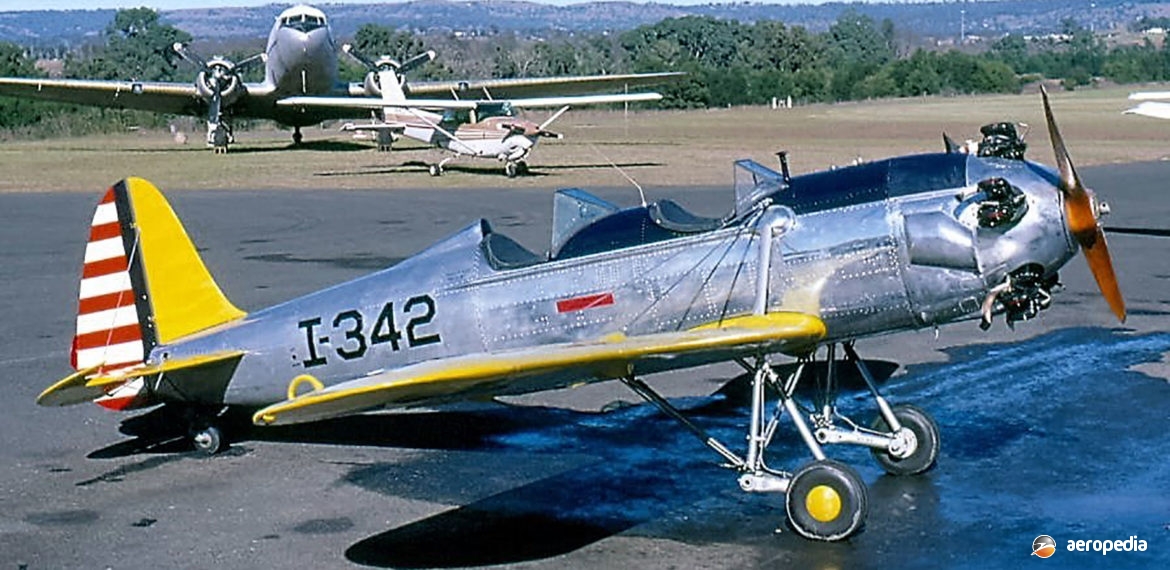Photograph:
Ryan PT-22 Recruit VH-NEA (c/n 1590 ) at Camden, NSW in June 1987 (David C Eyre)
Country of origin:
United States of America
Description:
Two-seat ab-initio military trainer
Power Plant:
One 119 kw (160 hp) Kinner R-540-1 five-cylinder air-cooled radial engine
Specifications:
- Wingspan: 9.16 m (30 ft 1 in)
- Length: 6.83 m (22 ft 5 in)
- Height: 2.19 m (7 ft 2 in)
- Wing area: 12.47 m² (134.25 sq ft)
- Max speed: 206 km/h (128 mph)
- Cruising speed at 1,650 rpm at 914 m (3,000 ft): 187 km/h (116 mph)
- Stalling speed flaps down: 100 km/h (62 mph)
- Service ceiling: 2,053 m (14,800 ft)
- Rate of climb: 262 m/min (860 ft/min)
- Range: 523 km (325 miles)
- Empty weight: 593 kg (1,307 lb)
- Loaded weight: 844 kg (1,860 lb)
History:
Although looking somewhat similar to the Ryan STA/STM series of two-seat military trainers, the Ryan PT-22 was in fact an entirely different aeroplane built by the same manufacturer. The main external difference between the two was that the PT-22 had a Kinner radial engine as opposed to the in-line Menasco unit, and the undercarriage legs were exposed instead of being enclosed in fairings and wheel pants. Other differences were that the PT-22 had a larger cockpit, to permit parachutes to be worn, and the wing was slightly swept back.
With World War II imminent, the Ryan Aeronautical Company received a contract in June 1939 to develop a trainer for the US military training programme, and a version of the STA-1, known as the XPT-16 was built, 15 examples being produced. Subsequently, in 1940, a developed version appeared, known as the PT-20, which was followed by the PT-21. These led to the PT-22 Recruit, known as the ST3-KR, for the US Army and US Navy. Twenty-five ST-3s were ordered for the Netherlands but were not delivered due to the war situation. These were taken over by the US military and became known as the PT-22A.
Some 250 examples were fitted with the Kinner R-540-3 engine and became known as the PT-22C. In all, 1,048 PT-22s were built, including the 25 Dutch aircraft mentioned. Production concluded in 1942. Other variants in the series included the ST-3S fitted with Edo floats, and a civil variant of the PT-21/-22 series fitted with a civil model of the Kinner radial, known as the R-55, which developed 119 kw (160 hp) at 1,800 rpm at sea level.
After their retirement from military service, large numbers found their way on to the US civil register, and about 100 are believed to be still extant. One aircraft was imported by a Sydney, NSWB enthusiast in early 1984 and became VH-NEA (c/n 1590 – ex N56534, NC56534) in November 1985. A further example arrived late in 1986 in Melbourne, VIC becoming VH-RPT³ (c/n 1039 – ex N48552, NC48522, 41-1918). Built as a PT-21, this latter aircraft had its engine replaced at some stage by a slightly up-rated Kinner engine and was registered as an ST3-KR, the manufacturer’s designation. In 1998 an example was imported into New Zealand, becoming ZK-RYN (c/n 2062) and being based in the Auckland area.
The PT-22 was a low-wing braced monoplane, the wing having spruce spars with aluminium-alloy ribs, alclad covering back to the front spar, and fabric covering overall. The fuselage structure consisted of nine aluminium-alloy bulkheads and six pieces of pre-formed alclad skin. The tail unit was of the braced aluminium type, with aluminium alloy framework, fabric covered. Accommodation was for two in tandem open cockpits with complete dual controls and duplicated instruments, and a baggage compartment accessible from the exterior.

